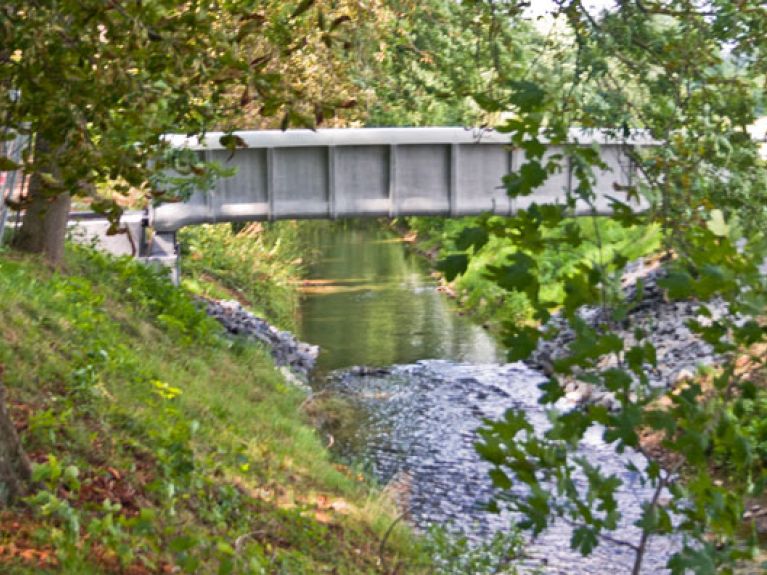Team spirit fosters innovation
Eastern Germany boasts plenty of scientific and business competence – a perfect environment for innovation. An initiative is supporting good ideas and promoting cooperation.

It’s nine metres long, two and a half metres wide and a minor sensation: in 2006 a pedestrian bridge in the Saxon town of Oschatz caused quite a stir. It weighs five tonnes but can carry a weight of 38 tonnes. The bridge’s secret lies in the materials it’s made of: glass and carbon fibres. That makes it lighter and a good deal tougher than a structural steel construction. The bridge was built by a consortium of project partners headed by Manfred Curbach, professor at the Technische Universität Dresden’s Institute of Reinforced Concrete and Solid Construction.
The team has used the same materials to rehabilitate a department store in Prague and to reinforce a building belonging to Würzburg-Schweinfurt University of Applied Sciences. “All these projects are just the tip of the iceberg,” Curbach believes. His goal is to see 20 percent of the heavy, corrosion-prone steel used in building worldwide replaced by the light-weight material carbon within the next ten years, making the construction sector more profitable, more efficient and more sustainable. Given the scale of the challenge and the extensive experimentation it requires, Curbach soon realized that he would need the help of numerous research partners to implement his plan. He also felt that it was important to put the scientific results into practice and pass on the knowledge to companies across the globe.
He and his team worked out what the undertaking would cost – and it was a substantial amount. “It was at precisely this juncture that we learned of a new funding programme by the Federal Ministry of Education and Research (BMBF),” he recalls. The Twenty20 – Partnership for Innovation initiative, which was launched in August 2012, is part of the Entrepreneurial Regions programme that is designed to improve the overall conditions for innovation in eastern Germany’s five federal states.
While Brandenburg, Mecklenburg-Western Pomerania, Saxony, Saxony-Anhalt and Thuringia boast plenty of – sometimes outstanding – scientific and business competence, this has so far only rarely resulted in innovation. “The funding programme helps companies and research institutions to overcome boundaries and work together with partners from all sorts of regions and sectors. That enables them to develop entirely new application areas,” explains BMBF section head Hans-Peter Hiepe. It’s not just a case of technology transfer, he says, but also of cultural change: “The cooperation projects are designed to promote more entrepreneurial thinking and a stronger market orientation in the new federal states’ business and research sectors.” Between now and 2019/2020, the Federal Government will be providing a total of up to 500 million euros in funding.
Curbach and his C³ – Carbon Concrete Composite – project team were among those who applied for funding under this programme – and one of the ten project teams whose proposals were approved in July 2013. A key formal condition was that the project consortia be made up of partners from eastern Germany’s five federal states and at least one partner from another federal state. Some of the projects being funded are also cooperating with international partners, e.g. the consortium HYPOS – Hydrogen Power Storage & Solutions East Germany. The team is looking for ways to convert excess electricity obtained from renewable energy sources into hydrogen. Such “green” hydrogen is an interesting prospect for, say, the chemical industry or electromobility. But it’s still too expensive.
“Our aim is to significantly improve the profitability of the green hydrogen,” explains Professor Ralf Wehrspohn, director of the Fraunhofer Institute for Mechanics of Materials in Halle. That’s why his team is working, for example, on new, larger facilities that can be connected to grids which use regenerative power. The 90-odd partners want to further develop their idea along the entire value chain. “We could never implement this project on our own,” says Wehrspohn.
That’s also true of the other projects funded under the Twenty20 initiative. Global problems too can be more successfully solved through cooperation – including infectious diseases that could evolve into global pandemics. Finding new ways to detect such diseases early on and to stem and successfully combat them is the goal of the joint project InfectControl 2020. The new techniques, products and services being developed will benefit not only the medical sector but also other areas like agriculture, mobility and infrastructure.
Today, innovation is no longer something that goes on behind closed laboratory doors. Exchange between different scientific disciplines and technologies as well as sectors and markets is becoming increasingly important. Twenty20 is helping to put the various pieces of the puzzle together.
www.unternehmen-region.de/de/6829.php
www.unternehmen-region.de/de/7665.php
www.infectcontrol.de/index.html
© .de - Deutschland.de, www.deutschland.de